2014 AUDI TT ROADSTER warning
[x] Cancel search: warningPage 108 of 244

106 Safet y belt s
Pregnant women must also be properly
restrained
The best way to protect the fetus is to make
sure that expectant mothers always wear
safety belts correctly -throughout the preg
nancy.
Fig . 1 10 S afety be lt pos it io n dur ing p regnancy
To provide maximum prote ction , safety belts
must always be po sitioned correctly on the
wearer's body
c> page 105 .
• Adjust the front seat and head restraint cor
rect ly
c> page 60, General recommenda
tions.
• Make sure the seatback of the rear seat
bench is in up right posit io n and securely
latched in p lace before using the b elt .
• Hold the be lt by the tongue and pull it even
l y across the ches t and pelvis
c> fig. 110,
c>,& .
• Inse rt the tongue into the correct buckle of
yo ur seat until you hear it latc h securely
c> page 104 , fig . 108.
•Pullon the belt to make sure that it is se
curely latched in t he buckle .
A WARNING
Imprope rly positioned safety belts can
cause se rious personal injury in an acci
de nt.
-
- E xpec tant mothers mus t always wear the
lap po rtion of the safety b elt as low as
poss ible ac ross the pe lv is and be low the
ro unding of the a bdome n.
- Always read and heed all WARN INGS and
ot her impo rtan t info rma tion
c> .&. in Fas
tening safety belts on page 105.
Unfastening safety belts
Unbuckle the safety belt with the red release
button only a~er the vehicle has stopped .
,,
}_
Fig . 11 1 Rele asing the ton gu e from the buc kle
• Push the red release b utton on the buckle
c> fig . 111. T he be lt tongue will spring out
of t he b uckle
c> ,& .
N 0 ;c
a1i
• Let the belt wind up on the retractor as you
guide the belt tongue to its stowed position .
A WARNING
-
Never unfasten safety belt whi le the vehi-
cle is mov ing . Do ing so will increase yo ur
r isk of being i njured o r kill ed .
Improperly worn safety belts
Incorrectly positioned safety belts can cause
severe injuries.
Wearing safety belts improper ly can ca use se
rious injury or deat h. Safety belts can o nly
work when they are correc tly positioned on
the body . Improper seat ing positions reduce
the effectiveness of safety be lts and will even
increase the risk of inju ry and death by mov
ing the safety be lt to crit ical areas o f the
body . Imp roper seati ng po siti ons also in
c rease the risk of serious injury and death
whe n an a irbag dep loys and strikes an occu
pant who is not in the co rrect seating posi
t ion. A driver is respons ible for the safety of
all veh icle occupants and especially for chil
dren . There fore:
• Never pe rm it anyone to assume an incorrect
sitt ing position in the vehicle while trave ling
c> ,& . ~
Page 109 of 244
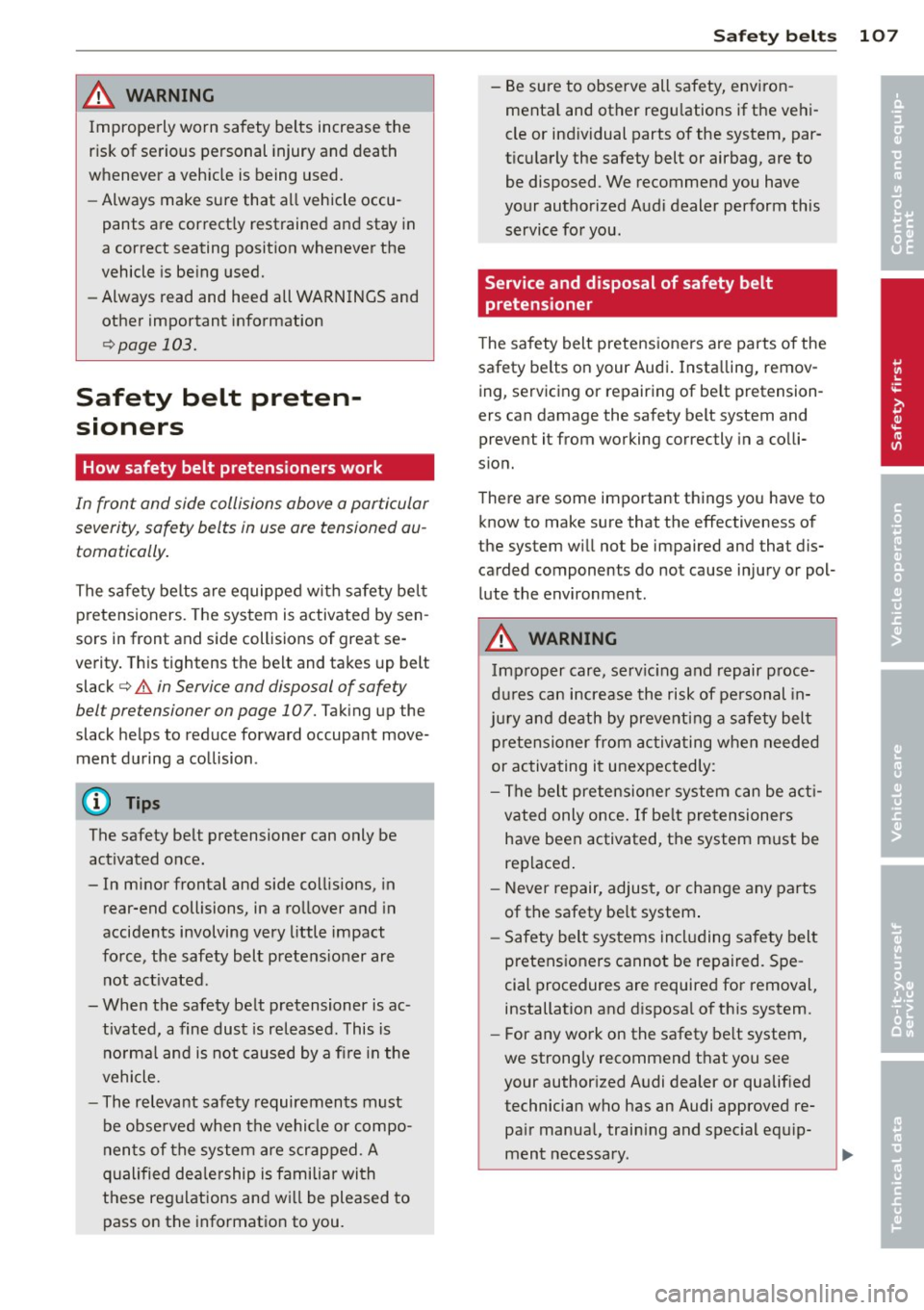
& WARNING
Improperly worn safety belts increase the
risk of serious personal injury and death
whenever a vehicle is being used.
- Always make sure that all vehicle occu
pants are correctly restrained and stay in
a correct seating position whenever the
vehicle is being used.
- Always read and heed all WARNINGS and
other important information
Q page 103.
Safety belt preten
sioners
How safety belt pretensioners work
In front and side collisions above a particular
severity, safety belts in use are tensioned au
tomatically.
The safety belts are equipped with safety belt
pretensioners. The system is activated by sen
sors in front and side collisions of great se
verity. This tightens the belt and takes up belt
slack
Q &. in Service and disposal of safety
belt preten sioner on page 107.
Taking up the
slack helps to reduce forward occupant move
ment during a collision .
@ Tips
The safety belt pretensioner can only be
activated once.
- In minor frontal and side collisions, in
rear-end collisions, in a rollover and in
accidents involving very little impact
force, the safety belt pretensioner are not activated.
- When the safety belt pretensioner is ac
tivated, a fine dust is released. This is
normal and is not caused by a fire in the
vehicle.
- The relevant safety requirements must
be observed when the vehicle or compo
nents of the system are scrapped. A
qualified dealership is familiar with
these regulations and will be pleased to
pass on the information to you.
Safety belts 107
-Be sure to observe all safety, environ
mental and other regulations if the vehi
cle or individual parts of the system, par
ticularly the safety belt or airbag, are to be disposed. We recommend you have
your authorized Audi dealer perform this service for you.
Service and disposal of safety belt
pretensioner
The safety belt pretensioners are parts of the
safety belts on your Audi. Installing, remov
ing, servicing or repairing of belt pretension
ers can damage the safety belt system and
prevent it from working cor rectly in a colli
sion.
There are some important things you have to know to make sure that the effectiveness of
the system will not be impaired and tha t dis
carded components do no t cause injury or pol
lute the environment.
& WARNING
Improper care, servicing and repair proce
dures can increase the risk of personal in
jury and death by preventing a safety belt
pretensioner from activating when needed
or activating it unexpectedly :
- The belt pretensioner system can be acti
vated only once. If belt pretensioners
have been activated, the system must be
replaced.
- Never repair, adjust, or change any parts
of the safety belt system.
- Safety belt systems including safety belt
pretensioners cannot be repaired. Spe
cial procedures are required for removal,
installation and disposal of this system.
- For any work on the safety belt system,
we strongly recommend that you see
your authorized Audi dealer or qualified
technician who has an Audi approved re pair manual, training and special equip
ment necessary . •
•
Page 112 of 244
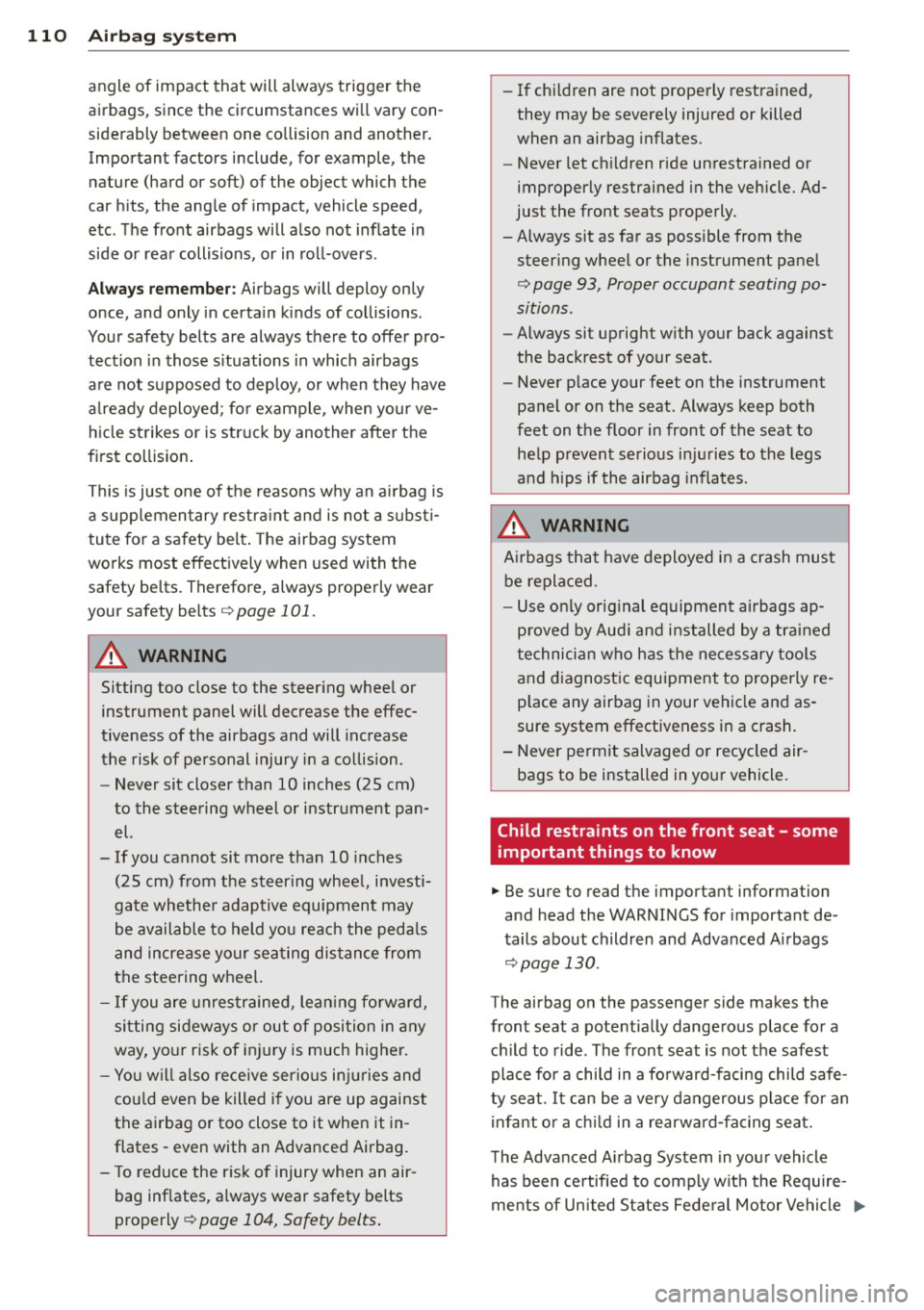
110 Airbag system
angle of impact that will always trigger the
airbags, since the circumstances will vary con
siderably between one collision and another.
Important factors include, for example, the
nature (hard or soft) of the object which the
car hits, the angle of impact, vehicle speed,
etc. The front airbags will also not inflate in
side or rear collisions, or in roll-overs.
Always remember: Airbags will deploy only
once, and only in certain kinds of collisions.
Your safety belts are always there to offer pro
tection in those situations in which airbags
are not supposed to deploy, or when they have
already deployed; for example, when your ve hicle strikes or is struck by another after the
first collision.
This is just one of the reasons why an airbag is
a supplementary restraint and is not a substi
tute for a safety belt. The airbag system
works most effectively when used with the
safety belts. Therefore, always properly wear
your safety belts¢
page 101.
A WARNING
Sitting too close to the steering wheel or
instrument panel will decrease the effec
tiveness of the airbags and will increase
the risk of personal injury in a collision .
- Never sit closer than 10 inches (25 cm)
to the steering wheel or instrument pan el.
- If you cannot sit more than 10 inches
(25 cm) from the steering wheel, investi
gate whether adaptive equipment may
be available to held you reach the pedals
and increase your seating distance from
the steering wheel.
- If you are unrestrained, leaning forward,
sitting sideways or out of position in any
way, your risk of injury is much higher.
- You will also receive serious injuries and
could even be killed if you are up against
the airbag or too close to it when it in
flates -even with an Advanced Airbag.
- To reduce the risk of injury when an air
bag inflates, always wear safety belts
properly
c::> page 104, Safety belts.
- If children are not properly restrained,
they may be severely injured or killed
when an airbag inflates.
- Never let children ride unrestrained or
improperly restrained in the vehicle. Ad
just the front seats properly.
- Always sit as far as possible from the steering wheel or the instrument panel
¢ page 93, Proper occupant seating po
sitions.
- Always sit upright with your back against
the backrest of your seat.
- Never place your feet on the instrument
panel or on the seat. Always keep both
feet on the floor in front of the seat to help prevent serious injuries to the legs
and hips if the airbag inflates.
A WARNING
Airbags that have deployed in a crash must
be replaced.
- Use only original equipment airbags ap
proved by Audi and installed by a trained
technician who has the necessary tools
and diagnostic equipment to properly re
place any airbag in your vehicle and as
sure system effectiveness in a crash.
- Never permit salvaged or recycled air bags to be installed in your vehicle.
Child restraints on the front seat - some
important things to know
.. Be sure to read the important information
and head the WARNINGS for important de
tails about children and Advanced Airbags
¢page 130.
The airbag on the passenger side makes the
front seat a potentially dangerous place for a
child to ride. The front seat is not the safest
place for a child in a forward-facing child safe
ty seat.
It can be a very dangerous place for an
infant or a child in a rearward-facing seat.
The Advanced Airbag System in your vehicle
has been certified to comply with the Require
ments of United States Federal Motor Vehicle .,.
Page 113 of 244
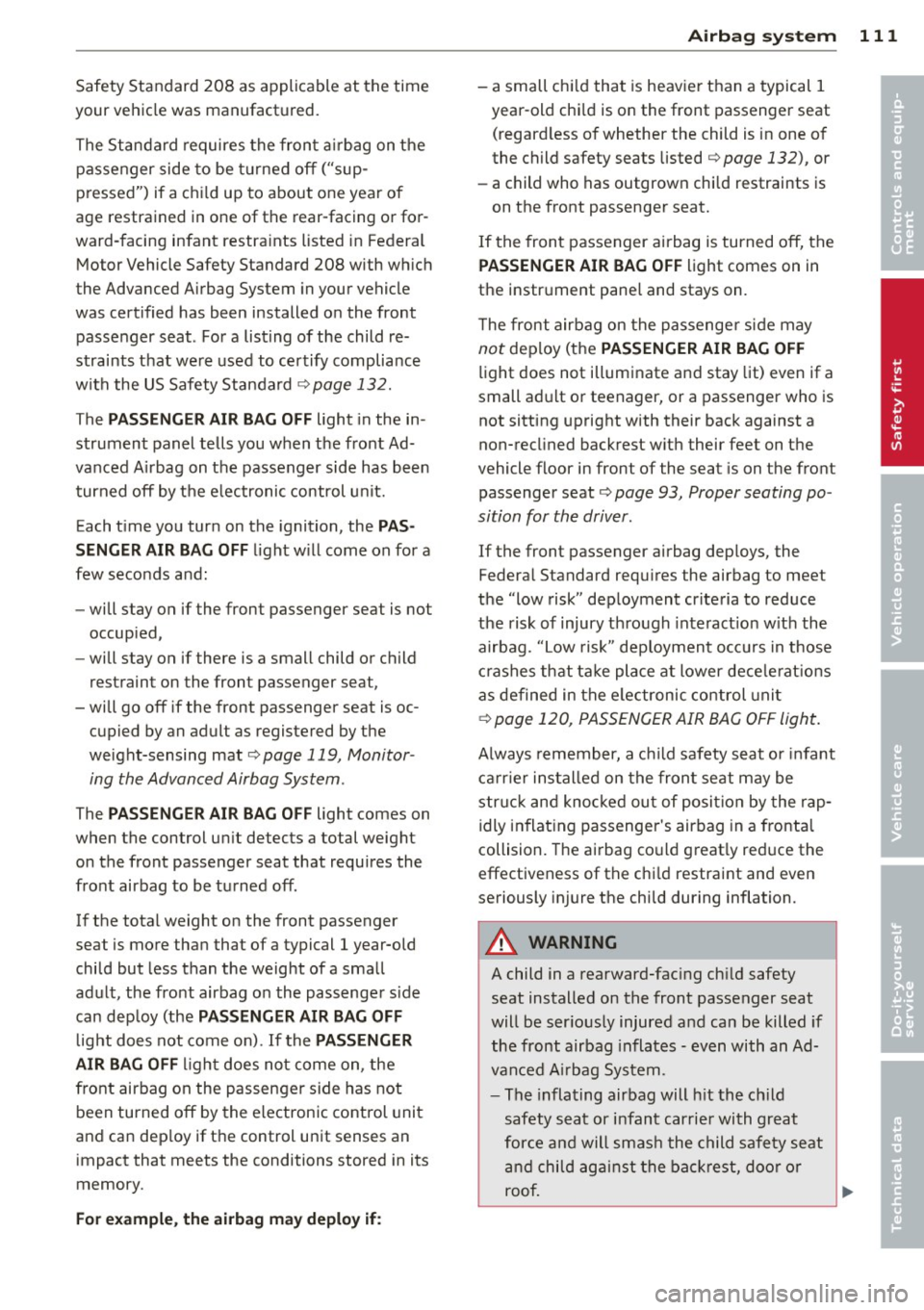
Safety Standard 208 as applicable at the time
your vehicle was manufactured.
The Standard requires the front a irbag on the
passenger side to be t urned off ("sup
pressed") if a child up to about one year of
age restrained in one of the rear -facing or for
ward -facing infant restra ints listed in Federal
Motor Vehicle Safety Standard 208 with wh ich
the Advanced Airbag System in your vehicle
was certified has been installed on the front passenger seat. Fo r a listing of the child re
straints that were used to certify compliance
with the US Safety Standard
¢ page 132.
The PAS SENG ER AIR BAG OFF light in the in
strument panel tells you when the front Ad
vanced A irbag on the passenger side has been
turned off by the e lectronic control u nit.
Each t ime you turn on the ignition, the
PAS
SENGER AIR BAG OFF
l ight w ill come on for a
few seconds and:
- will stay on if the front passenger seat is not
occupied,
- will stay on if there is a small child or child
restraint on the front passenger seat,
- wi ll go off if the front passenger seat is oc
cupied by an adult as registered by the
weight-sensing mat
¢ page 119, Monitor
ing the Advanced Airbag System.
The PASSENGER AIR BAG OFF light comes on
when the control un it detects a total weight
on the front passenger seat that requires the
front airbag to be turned off .
If the total weight on the front passenger
seat is more than that of a typical 1 year-old
chi ld but less than the weight of a small
ad ult, the front airbag on the passenge r side
can dep loy (the
PASSENGER AIR BAG OFF
light does not come o n). If the PASSENGER
AIR BAG OFF
l ight does not come on, the
front airbag on the passenger side has not
been turned off by the electronic control unit
and can dep loy if the control unit senses an
impact that meets the conditions stored in its
memory.
For e xample , the airbag may deploy if :
Airbag system 11 1
- a small child that is heav ie r th an a typical 1
year -old chi ld is o n the front passenger seat
(regard less o f whether the child is in one o f
the child safety seats listed ¢
page 132), or
- a child who has outgrown child restraints is
on the front passenger seat.
If the front passenger airbag is turned off, the
PASSENGER AIR BAG OFF light comes on in
the instr ument pane l and stays on.
T he front airbag on the passenge r side may
not deploy (t he PASSENGER AIR BAG OFF
light does not illuminate a nd stay lit) even if a
small ad ult or teenager, or a passenger who is
not sitting upright with their back against a
non-recl ined backrest w ith their feet on the
vehicle floor in front of the seat is on the front
passenger seat ¢
page 93, Proper seating po
sition for the driver.
If the front passenger airbag dep loys, the
Federa l Standard requ ires the airbag to meet
the "low risk" dep loyment criteria to reduce
the risk of injury th rough interact ion w ith the
airbag. "Low risk" deployment occurs in those
crashes that ta ke place at lower dece le rat io ns
as de fined in the e lectronic co ntrol unit
¢ page 1 20, PASSENG ER AIR BAG O FF light.
Always remember, a c hild safety seat or infant
ca rr ier installed on the front seat may be
stru ck and kno cked out of po sit io n by the rap
idly in flat ing passenger 's airbag in a fronta l
collision. The ai rbag co uld great ly red uce the
effectiveness of the chi ld restraint and even
seriously in jure the child during inflation.
A WARNING
A child in a rearward-fac ing ch ild safety
seat installed on the front passenger seat
will be ser ious ly injured and can be killed if
the front airbag inflates - even with an Ad
van ced A irbag System.
- The inflating airbag will h it the ch ild
safety seat or infant carrie r with great
for ce and will smas h the child safety seat
a nd child ag ain st the ba ckrest, door o r
roof.
•
•
Page 114 of 244
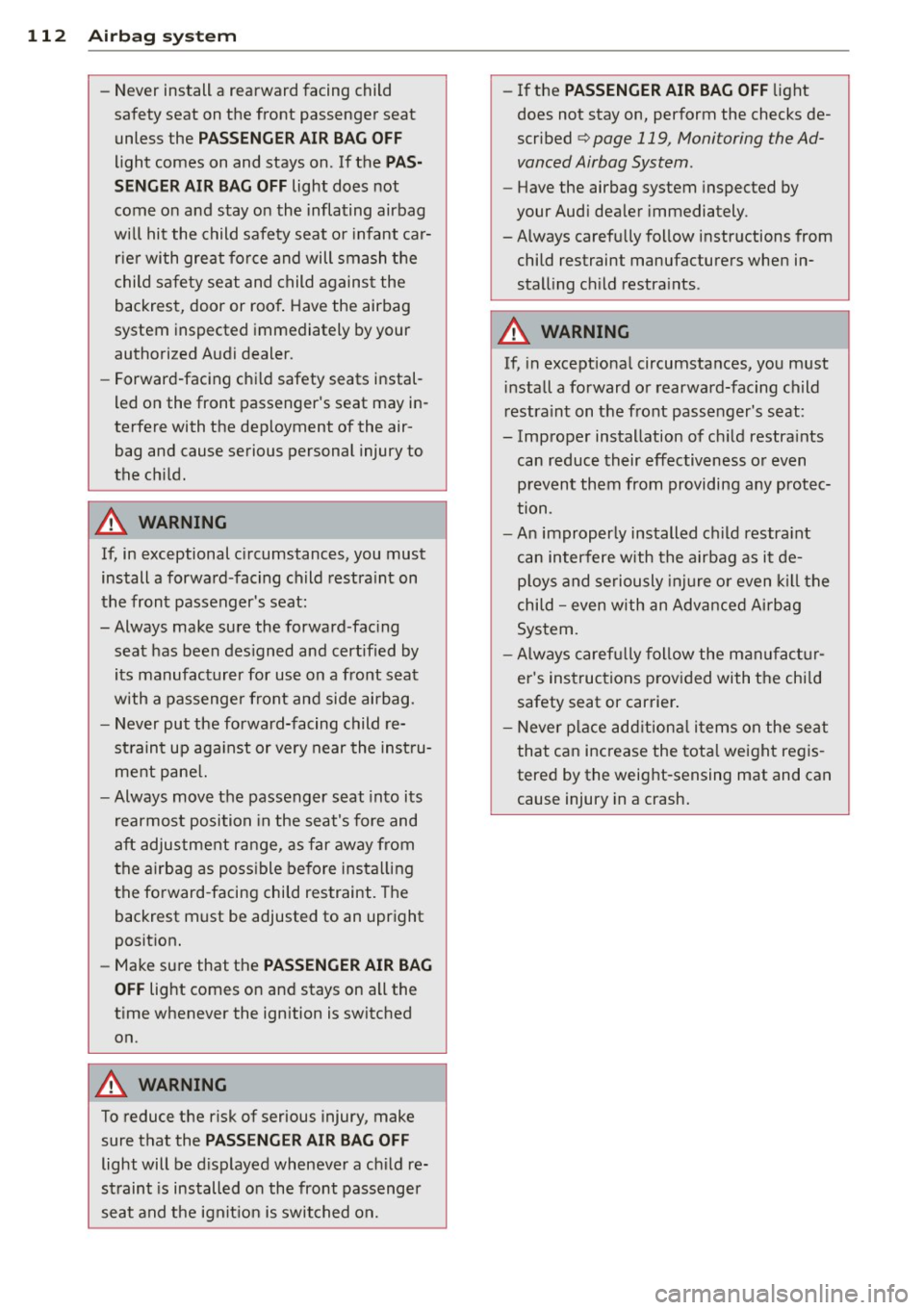
112 Airbag sys te m
- Never install a rearward facing child
safety seat on the front passenger seat
unless the
PA SS EN GER AIR B AG OFF
light comes on and stays on . If the P A S
SE NGER AI R BA G OFF
light does not
come on and stay on the inflating airbag
wi ll hit the child safety seat or infant car
rier with great force and will smash the
child safety seat and child agains t the
backrest, door or roo f. Have the airbag
system inspected immediately by your
authorized Audi dealer .
- Forward-facing chi ld safety seats instal
led on the front passenger's seat may in
terfere with the deployment of the air bag and cause serious personal injury to
the ch ild.
A WARNING
If, in exceptional c ircumstances, you must
install a forward -facing child restra int on
the front passenger's seat:
- Always make sure the forward -fac ing
seat has been des igned and certified by
its manufacturer for use on a front seat
with a passenger front and side airbag.
- Never put the forward-facing child re
straint up aga inst or very near the inst ru
ment pane l.
- Always move the passenger seat into its
rearmost position in the seat's fore and
aft adjustment range , as far away from
the a irbag as poss ible before installing
the fo rward-facing child restraint. The
backrest must be adjusted to an upright
position.
- Make sure that the
PASSENGER AIR BAG
OFF
light comes on and stays on all the
t ime whenever the ignition is switched
on.
A WARNING
To reduce the risk of serious injury, make sure that the
PASSENGER AI R BAG OFF
light will be d isplayed whenever a ch ild re
straint is installed on the front passenger
seat and the ignit ion is switched on. -
If the
PASSENGER AIR BAG OFF light
does not stay on, perform the checks de
scribed
<=> page 119, Monitoring the Ad
vanced Airbag System .
-Have the airbag system inspected by
your Aud i dea ler immediately.
- Always carefully follow instructions from
child restraint manufacturers when in
stall ing ch ild restra ints .
A WARNING
=
If, in except iona l circumstances, you must
i nstall a forward or rearwa rd-facing child
restra int on the front passenger's seat :
- Improper installation of ch ild restra ints
can reduce their effectiveness o r even
p revent them from providing any protec
tion .
- An improp erly installed ch ild restra int
can interfere with the airbag as it de
p loys and seriously inj ure o r even k ill the
child -even with an Advance d Airbag
System.
- Always carefu lly follow the m anu fact ur
er 's ins truc tions p rov ided with the chi ld
safety seat or carrier .
- Never p lace add itiona l it ems on the seat
that can increase the total weight regis
tered by the weight-sensing mat and can
cause injury in a crash.
Page 115 of 244
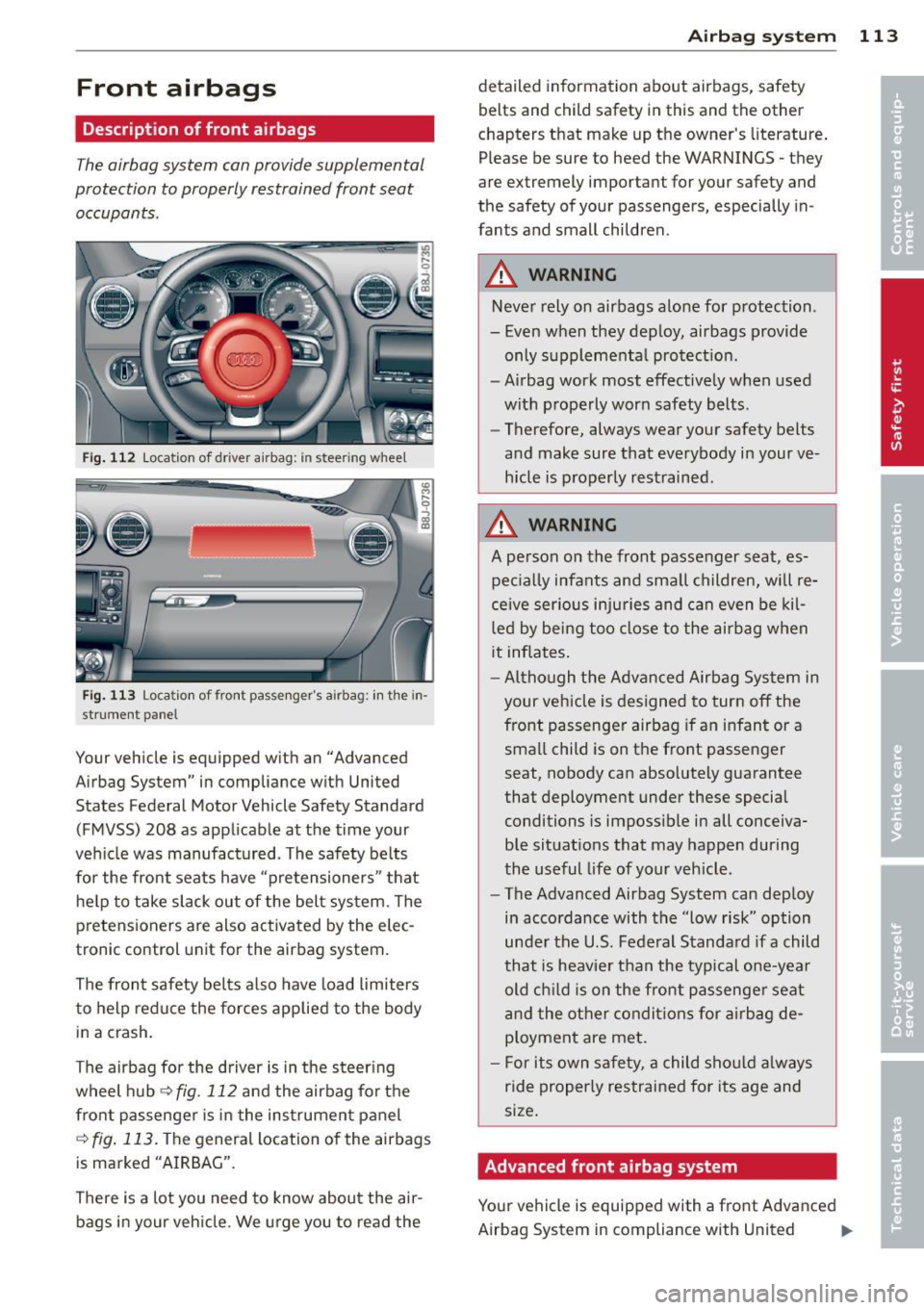
Front airbags
Description of front airbags
The airbag system can provide supplemental
protection to properly restrained front seat
occupants .
Fig. 112 Location of dri ver airbag: in steering whee l
Fig. 113 Location of front passe nger's ai rb ag : in the in
strument panel
Your vehicle is equipped with an "Advanced
Airbag System" in compliance with United
States Federal Motor Vehicle Safety Standard
(FMVSS) 208 as applicable at the time your
vehicle was manufactured . The safety belts
for the front seats have "pretensioners" that
help to take slack out of the belt system. The
pretensioners are also activated by the elec
tronic control unit for the airbag system.
The front safety belts also have load limiters
to help reduce the forces applied to the body
in a crash .
The airbag for the driver is in the steering
wheel hub¢
fig. 112 and the airbag for the
front passenger is in the instrument panel
¢fig. 113. The general location of the airbags
is marked "AIRBAG".
There is a lot you need to know about the air
bags in your vehicle. We urge you to read the
Airbag system 113
detailed information about airbags, safety
belts and child safety in this and the other
chapters that make up the owner's literature .
Please be sure to heed the WARNINGS - they
are extremely important for your safety and
the safety of your passengers, especially in
fants and small children.
A WARNING ,.;;
Never rely on airbags alone for protection .
- Even when they deploy, airbags provide
only supplementa l protection.
- Airbag work most effectively when used
with properly worn safety belts.
- Therefore, always wear your safety belts
and make sure that everybody in your ve
hicle is properly restrained.
A WARNING
A person on the front passenger seat, es
pecially infants and small children, will re
ceive serious injuries and can even be kil
led by being too close to the airbag when
it inflates .
- Although the Advanced Airbag System in
your vehicle is designed to turn off the
front passenger airbag if an infant or a
small child is on the front passenger
seat, nobody can absolutely guarantee
that deployment under these special
conditions is impossible in all conceiva
ble situations that may happen during
the useful life of your vehicle .
- The Advanced Airbag System can deploy
in accordance with the "low risk" option
under the U.S. Federal Standard if a child
that is heavier than the typical one-year
old child is on the front passenger seat
and the other condit ions for airbag de
ployment are met.
- For its own safety, a child should always
ride properly restrained for its age and
size.
Advanced front airbag system
-
Your vehicle is equipped with a front Advanced
Airbag System in compliance with United
Ill>
Page 117 of 244

-a small adu lt or teenager is on the front pas
senger seat
- a passenger who is not sitting upright w ith
their back against a non-reclined backrest
with their feet on the vehicle floor in front
of the seat is on the front passenger seat.
I f the front passenger airbag deploys, the
Federal Standard requires the airbag to meet
the " low risk" deployment criteria to help re
duce the risk of injury through interaction
with the airbag . "Low risk" deployment occurs
in those crashes that take place at lower de
celerations as defined in the electron ic control
un it
¢ page 119 .
Alw ays rem emb er: Please be sure to read the
important information in the sections that
follow and be sure to heed all of the WARN
INGS.
A WARNING
To reduce the risk of injury when an airbag inflates, a lways wear safety belts prope rly.
- If you are unrestrained, lean ing forward,
sitting sideways or out of position in any
way, your risk of inj ury is much higher.
- You w ill also receive serious inju ries and
cou ld even be killed if you are up against
the a irb ag or too close to it when it in
flates - even with an Advanced Airbag
¢page 109 .
.&_ WARNING
-
A child in a rearward-facing child safety
seat installed on the front passenger seat
w ill be seriously injured and can be k illed if
the front a irbag inflates - even with an Ad
vanced Airbag System.
- Although the Advanced Airbag System in
your vehicle is designed to turn off the
front a irbag when a rearward-fac ing
child restraint has been installed on the
front passenger seat, nobody can abso l u te ly guarantee that deployment is im
poss ible in a ll conceivable situations that
may happen d uring the useful life of your
vehicle.
A irbag system 11 5
-The inflating airbag will hit the child
safety seat or infant carrier with great
force and will smash the child safety seat and child against the backrest, doo r, or
roof.
- If you must install a rearward fac ing
child safety seat on the front passenger
seat because of exceptional c ircumstan
ces and the
PASSENGER AIR BAG OFF
light does not come on and stay on have
the airbag sys tem inspected by your Audi
dea ler.
.&_ WARNING
I f, in except iona l circumstances, you must
install a forward-facing child restraint on
the front passenger's seat:
- Always make sure the forward -facing
seat has been designed and certified by its manufacturer for use on a front seat
with a passenger front and s ide a irbag.
- Never put the forward-facing child re
straint up against or very near the instru
ment panel.
- Always move the passenger seat into its
rearmost pos ition in the seat's fore and
aft adjustment range, as far away from
the airbag as possible, before installing
the forward-fac ing ch ild restra int. The
backrest must be ad justed to an upright
position.
- Make sure that the
PASSENGER AIR BAG
OFF
li ght comes on and stays o n all the
time wheneve r the ig nit ion is swit ched
on.
Advanced Airbag System components
T he front passenge r seat in yo ur vehicle has a
lot of very important parts of the Advanced
Airbag System in it . These parts include the
weight-sensing mat, sensors, wiring, brack ets, and more. The funct ion of the system in
the front passenger seat is checked by the
electronic control unit when the ignition is on .
The cont rol unit monitors the Advanced A ir
bag System and turns the airbag indicator
l igh t on when a malfunct ion in the system
•
•
Page 118 of 244

116 Airbag sys te m
components is detected . The function of the
airbag indicator light is described in greater
deta il below . Because the front passenger
seat contains important parts of the Ad
vanced A irbag System, you must take care to
prevent it from be ing damaged . Damage to
the seat may prevent the Advanced Airbag for
the front passenge r seat from doing its job in
a crash .
The front Ad vanced Airb ag System
consists of the following:
- Crash sensors in the front of the veh icle that
measure ve hicle acceleration/decele ra tion
to provide info rmation to the Advanced Air
bag System abo ut the severi ty of the crash.
- An electron ic co ntro l unit, with integra ted
crash sensors for front and side impacts .
T he cont ro l unit "decides " whethe r to fire
the front airbags based on the information received from the crash sensors . The contro l
unit a lso "decides" whether the safety belt
pre tensioners should be activated.
- An Advanced Ai rbag with gas generator for
the driver ins ide the steer ing whee l hub.
- An Advanced Airbag with gas generator in
s ide the inst rument panel for the front pas
senger.
- A weight -sens ing mat under the upholstery
padd ing of the front passenger seat cush ion
that measures the total we ight on the seat.
The information reg istered is sent continu
ous ly to the electron ic control unit to regu
late deployment of the front Advanced Air
bag on the passenger s ide.
- An airbag monito ring system and indicator
li ght in the instrument cluster
9 page 119.
- T he PASSENGER AIR BAG OFF light comes
on and stays on in the cente r of the instru
ment pane l
9 page 120, fig. 115 and tells
yo u when the front Advanced A irbag on the
passenge r side has been turned off.
- A senso r be low the safety bel t latch fo r the
fron t se at passenge r to me asu re the tension
on the safety belt . The tension on the safety
belt and the weight registe red by the
weight -sensing mat help the control unit
"decide" whether the front a irbag for the front passenge
r seat should be turned off or
not
¢ page 110, Child restraints on the
front seat -some important things to
know.
- A sensor in the safety be lt latch fo r the driv
er and for the front seat passenger that
senses whether that safety belt is latched or not and transmits this informa tion to the
electronic control un it .
.&_ WARNING
D amage to the fron t passenger seat can
p revent the fro nt airbag from wor king
pr operly.
- I mp roper repai r or disassembly of the
front passenge r and dr ive r sea t will pre
vent the Advanced Airbag System from
functioni ng p roperly.
- Repairs to the front passenge r seat mus t
be pe rformed by qu alifie d and p roperly
trained workshop personne l.
- Never remove the front p assenger o r
d river seat from the vehicle .
-Never remove th e upholstery from the
front passenger seat.
- Neve r d isassemble o r remove parts from
the sea t or discon nect wires from it.
- Never carry sha rp objects in yo ur poc kets
or p lace t hem on the seat. If the weight
sensing ma t in the passenger seat is
punctured it cannot work p roperly.
- Neve r carry things on y our la p or ca rry
objects on the passenger seat. S uc h
items can increase the weight registere d
by the weight -sensing mat and send the
wrong information to the airbag control
un it.
- Never store items under the front pas
senger seat. Parts o f the Advanced Air
bag System under the passenger seat
could be damaged, preventing them and
the airbag system from working proper ly.
- Never p lace seat covers or rep lacement
up ho lstery that have not been specifica l
ly approved by Audi on the front seats .
- Seat covers can prevent the Advanced
-
Ai rbag System from recognizing chi ld .,..